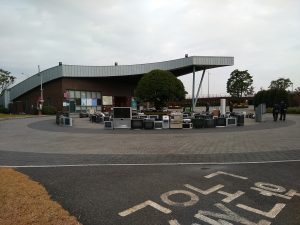These days Genco Gülan is working on his new installation in South Korea. The work at the Suncheon National Gardens, the work has a diameter of 20 meters and is composed of 300 old electronic devices; but none of them, most of them being TV moitors, are connected to electricity. Genco Gülan answered our questions about how the work emerged and what its objectives are.
How did this project emerge?
Labyrinths have been interesting for me for a long time. Mystic forms and their cultural references kept emerging in my paintings for a while. Frankly, I see them as a sort of metaphoric engine and a tool for participation. I also wanted to go from two to three-dimensionality. As Suncheon Bay International Eco-environmental Art Festival (SEEAF 2016) coordinated by Unesco AIAP-IAA asked me to contribute a project, I proposed the Last Labyrinth to them; as it was accepted, I readapted the project to the given space.
What is the conceptual point of departure in this work? Is it a permanent installation?
In my works I always own both the material and the form, and the conceptual references of the space. I find it very important that the Last Labyrinth composed of electronic materials stands in an intensely green park. At first it appears as if it does not belong into a such an environmentalist festival. Exactly for this reason it is crucial that it is at a green park in such a festival. As technology changes, so does nature. We must learn to manage this change properly! I wish the labyrinth was permanent but it isn’t; it will be on view for one month. But it receives a lot of public attention. Visitor reactions are very interesting and positive. Children sit down and meditatively watch the turned off TVs. They call my worka TV garden.
We generally think of artworks “consuming electricity” when we think about new media art. I guess that with your work you also bring criticism to that in a way.
I use the electronic equipment in the Last Labyrinth completely devoid of electricity. Their symbolic meaning matters to me, not their function. In fact when the viewers see the work they immediately call it a Video Art piece. Art aims at a perceptive communication; so the aim is to eat the grape, so to say. Kicking the vigneron, or even his existence o absence, are secondary issues. I find new media art’s aspect that exacerbates consumer fetishism very dangerous. Famous brands sell their phones to ten or twenty times their worth totally by mobilizing the semantic weaponry o art; and the viewer is ready to receive it. But they pay the price of the theatre play ticket to the wrong people; it is a black market, in a sense…
On the other hand, the technology becoming obsolete with the passage of time is a big problem for the artists and collectors of new media art alike.
At the end of the day, New Media art is about the ‘media technology’. Also semantically, the so-called ‘old media’ is more attractive since it is richer and has more layers. It is always much more important for me to push the limits of semantic vocabulary and viewer experience.
Then what is new media?
New media is a field with no fixed definition, and that is why it’s new. When it will be defined it will be old. That’s a fact.
And how should it be preserved, or should it be preserved at all?
Permanence is a relative concept. The choice of what you want to preserve can even be more important than preservation itself. For example in my labyrinth there are TV monitors that have been used as CCTV. As the same image constantly rotated on the screen , the tubes were burnt and the image was literally incised onto the screen. But does this or will this ever serve us? What excites me about New Media are concepts like Live, Life (alive). The online status sometimes allows it, although relatively. sharing immediately, when it’s fresh, instead of preserving… I also like the fish when it’s fresh; I try to avoid canned fish. But as pollution increases, it gets harder to find fresh fish; you know that already…
We keep hearing that the contemporary art scene in South Korea is very dynamic. What are your observations and experiences?
This festival is my 4th exhibition in South Korea. I have previously participated to two group shows in Incheon and did a solo show in Seoul. The country is very dynamic but also conservative; they are like us in some ways. On the other hand, it is a country that managed to produce a world-wide artist like Nam June Paik. I had the privilege to meet the master himself. You can’t be a worldwide country without producing worldwide artists or sports people.
Click for the artist’s page.



